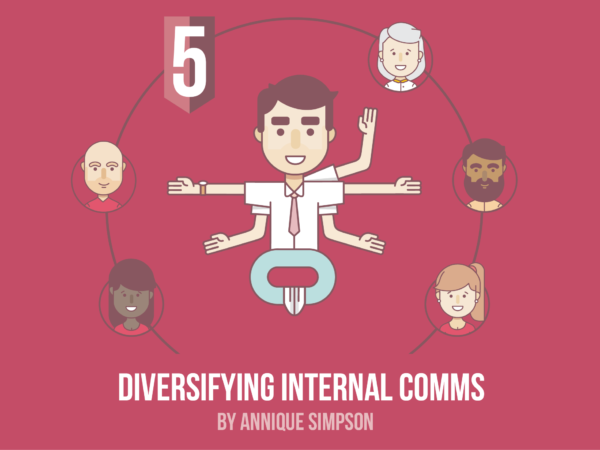
Have you ever taken the opportunity to work flexibly?
Flexible working is a workplace perk that’s becoming increasingly sought-after by employees.
We’d hedge our bets that if your job happens to include this particular benefit, you probably have used it at some point in your career.
And who could blame you? With all the flexible technology we now have at our disposal – we can literally work wherever we want, whenever we want.
Giving us a greater amount of freedom and autonomy to take care of our lives outside the workplace.
Need to get a pressing report over the line? Not to worry – get stuck in on your living room sofa with a nice cuppa. Got a meeting you absolutely have to be in, but need to look after the little ones? Just fire up Skype (but remember to lock your door).
Technology is in free-flow – and so are our organisations.
Subscribe to our Friday Ketchup to get handpicked internal comms and employee engagement insights, facts, and ideas squeezed straight into your inbox, every Friday.
Welcome to the flexible workplace
The rigid regime of the traditional 9-5 working day is starting to thaw, as new research suggests it’s losing favour with a whopping 90% of employees.
And whereas in the past, demand for flexible working most typically arose from female employees saddled with the task of juggling work with childcare, this gender boundary is also beginning to break down as greater numbers of male employees call for greater flexibility within their working lives too.

In fact, it’s been found that some employees would even be willing to take a pay cut in order to reduce the hours that they work.
But it’s not just growing demand that’s defining it as not just a nice-to-have, but a must-have in organisations.
Previous research has also shown that flexible working is coupled with several desirable benefits – namely greater employee commitment and well-being, reduced absenteeism, and even increased productivity. And perhaps best of all, 65% of business leaders recognise this!
Flexible working is coupled with several desirable benefits – including greater employee commitment and well-being, reduced absenteeism, and increased productivity
Going against the grain
So what’s not to like? So long, 9 to 5 – flexiworking for everyone!
But with all this insight to hand, we think you’ll agree that it seems bizarre that despite acknowledging the benefits, only half of UK organisations offer some form of flexible working, and nine out of ten job ads don’t list the job as flexible – even if it comes with this perk.
According to research, over 70% of medium-sized organisations say they’d never consider offering full-time working from home to employees (with a third anxious that it would have a negative impact on the business). And older employees, and those without children, say they receive far less flexibility than parents – supported by just 26% and 34% of companies, respectively.
It seems many organisations are stuck in an outdated rut, wary of implementing flexiworking despite all the known advantages for both employees and organisational success.
So it begs the question – why are we going against the grain?
Changing attitudes and altering beliefs
The fact is that when it comes to flexible working, we need to alter attitudes as much as working practices.
Nearly half of working mothers say their reliance on flexible working has impeded their career progression, continually being passed over for promotion.
29% say they face workplace discrimination because of working flexibly.
2/5 of low-paid young parents report being punished for requesting access to flexible working – receiving fewer hours, being signed on to worse shift patterns, and even being laid off entirely.
29% of working mothers say they face workplace discrimination because they work flexibly
And there’s an unfortunate stigma attached to flexible working that those who use it are for some reason less committed and put less effort in to their work.

It’s plain to see that working flexibly comes with a series of associated stereotypes – that flexible workers are lazier, less dedicated, and less worthy of more high-pressure, labour-intensive roles than their schedule-bound counterparts.
But the fact that flexible working is proven to encourage greater productivity flies fast in the face of these preconceptions. And as for dedication, it’s more likely that through being granted the freedom to sufficiently balance work and personal commitments, employees will have greater respect for their employer, be more engaged, and in return show increased loyalty to their organisation.
Flexible working comes with a series of associated stereotypes – that flexible workers are lazier, less dedicated, and less worthy of more high-pressure, labour-intensive roles
Making flexible working work for everyone
Of course, it’s important that every employee has access to the benefits of flexible working, not just those who vocally ask for it. While some employees might not have their own children, they may have caring duties, volunteer for good causes, or perhaps even wish to gain some extra skills or qualifications outside the workplace so they can be better at their jobs.
If you don’t take everyone’s needs into consideration, you may end up sowing the seeds of discontent and resentment across employees who miss out on it simply because they may have fewer pressing personal commitments outside the office.
And what about the Millennials and Gen Z’ers? It’s well-known that as the workforce is changing, so too is what it desires in the workplace.
57% of Millennials say that work-life balance is very important to them, and the lack of a healthy work-life balance is one of the top reasons they leave their jobs.
And Gen Z employees – those just entering the world of work – expect it as a standard feature of their benefits package. As the workforce evolves – leaders must keep pace.
The value of flexible working
Flexible working is an essential step towards ensuring that employees can strike a healthy balance between all the responsibilities they have to juggle on a day-to-day basis. And it can be done successfully, with great results.
One great example is Ricardo Semler, whose company Senco employes a radically democratised culture, where employees have full control over when they work, where they work, and the holidays they take.
Ricardo’s ideas on the workplace, organisational culture and education are truly novel and inspiring, so we’ll let him explain the rest:
We need to advance beliefs around flexible working to the same extent as it’s advancing in popularity
The main barrier preventing widespread acceptance of flexiworking is the attitudes surrounding it. We just need to advance beliefs around flexiworking to the same extent as it’s advancing in popularity.
Seeing flexible working for the value it can bring to an organisation – not as an excuse to escape the demands of the workplace.
After all, does the where and how of the work really matter – so long as the outcome is successful?
If you enjoyed our blog, you’ll love this TED Talk by Dan Thurmon on living life off-balance, on purpose. (Incudes juggling with axes on a 6-foot unicycle!):
Get in touch today to find out how we could help you transform your leaders and managers from average, to exceptional!
Got a brilliant idea you simply can’t keep to yourself?
We’re always looking for fresh faces to help us further the IC conversation by writing guest articles for our blog. If you want to make your voice heard on internal comms, employee engagement, change management or leadership development, we’d love it if you got in touch!












